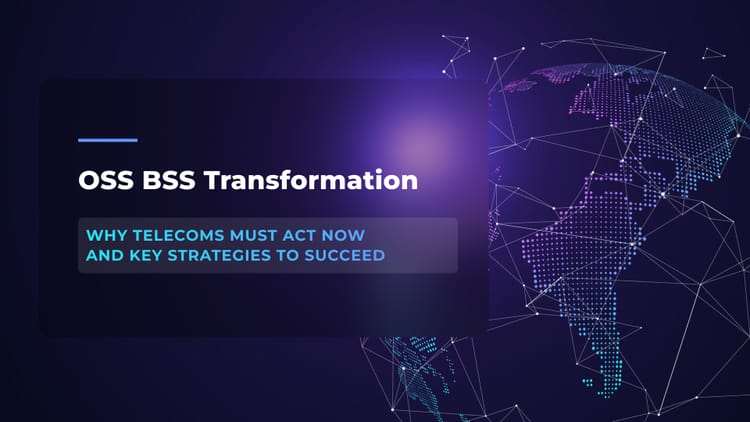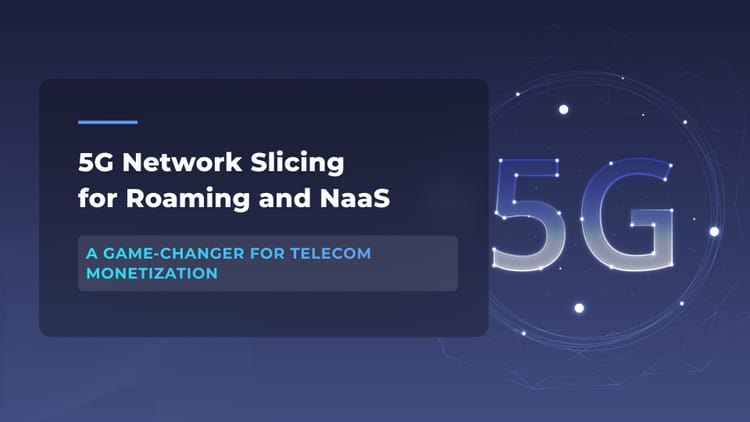SIMs Used in Telecom (And Why Shift From Traditional SIMs to eSIMs and iSIMs)
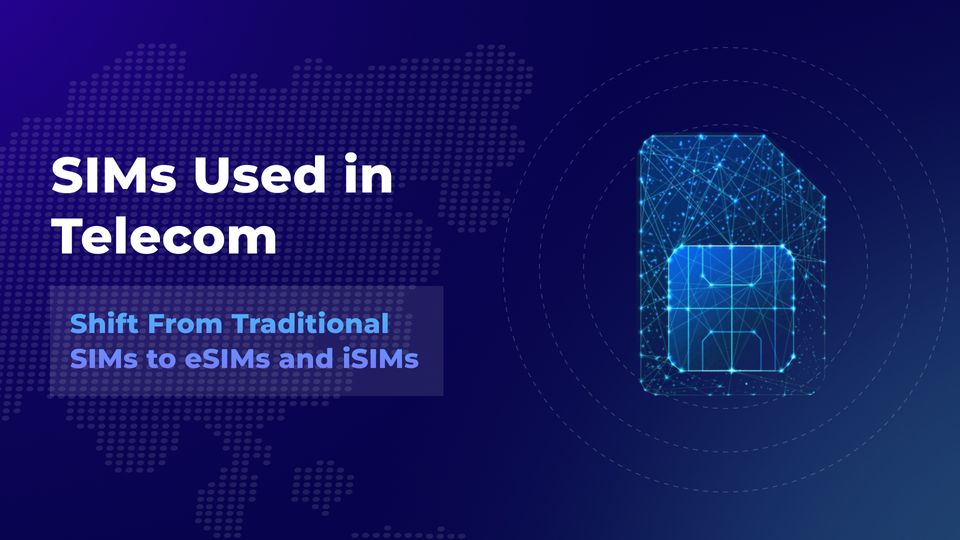
Telecom companies are at a critical point as leading IoT device providers, like Apple, move towards eSIM-only in some regions. Understanding their limitations, telcos around the world are giving up on traditional connectivity options in favor of IoT. However, research says that there are just a few years before eSIM technology will begin to be replaced with iSIM in this rapidly changing field.
Being a partner of leading telecom companies, we at Flyaps have seen firsthand the dynamic shifts propelled by emerging technologies and trends. We've played a pivotal role in revolutionizing BI systems for roaming analytics with AI algorithms for Yaana Technologies; we've also assisted in the creation of IoT platforms, smart billing solutions, and CRM/ERP systems through the integration of RPA. From our standpoint, we can confidently assert that the changes associated with SIM cards will have significant implications for telecom providers, device manufacturers, and end-users. These changes are irreversible, so we invite you to discuss how exactly they will shape the future of the industry.
In this article, you will find out how this new eSIM/iSIM is different from traditional SIM technology and how it impacts the telecom field in such areas as IoT and AI. We will also cover a few eSIM/iSIM use cases in the telecom, so keep reading for more.
How are eSIMs and iSIMs different from traditional SIMs?
Let’s kick things off with some definitions. An embedded SIM, known as eSIM, refers to a digital SIM card that is seamlessly integrated into device hardware. Unlike traditional physical SIM cards, which need to be inserted and replaced, eSIMs are integrated into a device during manufacturing. Thanks to eSIMs, you can switch between different mobile carriers and plans without buying a new physical SIM card. eSIMs are commonly found in smartphones, smartwatches, and other connected devices.
An iSIM, or integrated SIM, refers to the SIM card that is not only embedded in a device but specifically into its chipset or processor. It becomes an inherent part of the device's architecture.
Size is an advantage iSIMs have over eSIMs, as they are better suited for devices with limited space, such as smart glasses or smart watches. To compare, eSIM is 98% bigger to iSIM. iSIMs also have other important advantages:
1. iSIMs use significantly less power compared to traditional eSIMs or physical cards. They require 70% less energy to operate.
2. iSIMs can function with various kinds of mobile networks (such as 3G, 4G, or 5G) and connect to services provided by any cellular carrier, regardless of the specific technology being used by the network.
3. iSIM ensures robust security. It's securely integrated into a system-on-chip (SoC), getting a high level of protection. Additionally, manufacturers can customize the security features according to the specific needs of the device or their own preferences. The inclusion of a tamper-resistant element (TRE) as an independent hardware component also ensures consistent security and defends the iSIM against both physical and virtual attacks.
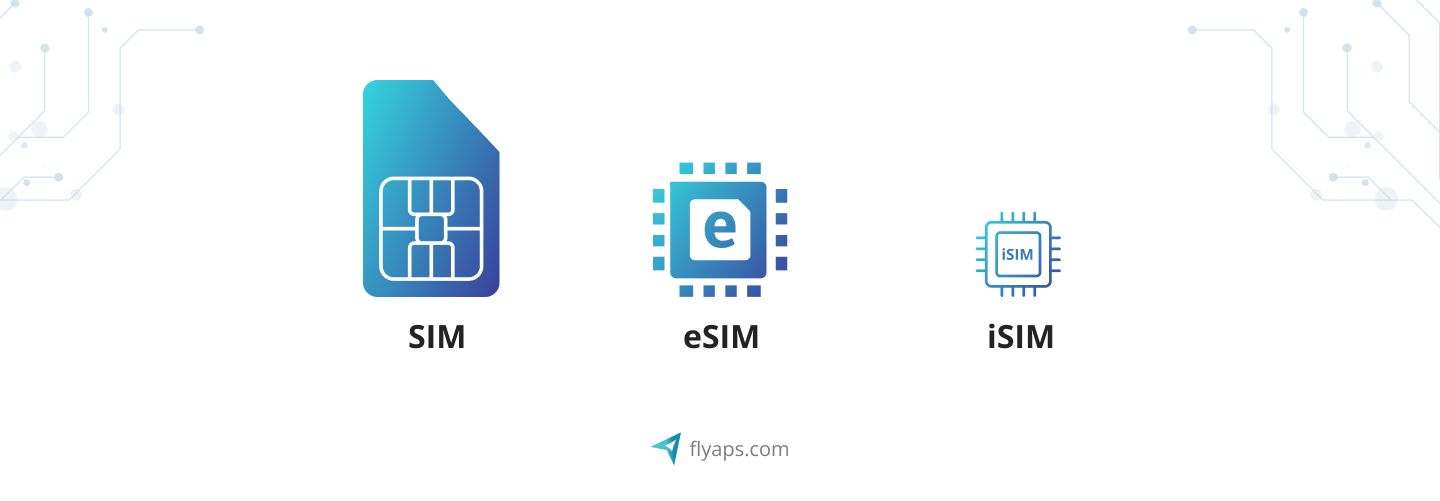
Think of traditional SIM cards as a physical key you use to unlock your phone's connection to a cellular network. It's a small, removable chip you insert into your device. Now, imagine your phone doesn't need a physical key anymore. Instead, it has a virtual key embedded inside it. That's what an eSIM is – a digital version of the traditional SIM card. It's built into your device, and you can switch between different carriers or plans without needing to change the SIM card physically.
So overall, iSIMs offer the same benefits as eSIMs, like flexibility, but they are more secure and energy-saving.
The role of eSIMs and iSIMs for the future of IoT and telecom industry
Since SGP.31 and SGP.32 (IoT standards specifications) were introduced, deploying eSIM IoT devices has become even more trouble-free. That is going to significantly facilitate its spreading.
IoT Analytics has predicted that the usage of eSIMs and iSIMs will grow a lot in 2023, with more than 500 million units being used. Their another research shows that eSIMs will become the main type of SIM card for devices in the next 2-3 years. iSIMs will break forward due to their extra security features, leading to major changes in the telecom landscape.
From cloud migration to telecom-specific AI solutions, we have delivered over 20 projects that are used by hundreds of MNOs and telecom companies worldwide. Check our capabilities and let’s discuss your next solution.
See our servicesWhat will change for telecoms exactly? First of all, by eliminating the need for physical SIM cards, telcos reduce the burden of managing large inventories and the associated costs. Instead of shipping physical SIM cards to each store and worrying about restocking, the company can digitally distribute eSIMs, minimizing logistical challenges.
Additionally, telcos already have started to focus on brand differentiation through digital onboarding experiences, offers, eShops, and value-added services to retain customers. With the ease of carrier switching thanks to eSIMs, telecom companies will be able to focus less on SIM manufacturing and more on providing a seamless and enjoyable customer experience to ensure client retention.
But there’s a need to note that the impact of eSIM/iSIM technology on third-party retail depends on market dynamics. In some markets, SIM sales could become fully digital, while in others, physical inventory may still be managed. Consumer habits are shifting towards digital channels, but the extent of this shift will vary across regions.
The usage of eSIMs may increase competition for roaming revenue, as local prepaid carriers offer competitive packages for tourists, challenging traditional postpaid roaming offers. The convenience of eSIMs may attract travelers to choose local prepaid options for short-term usage.
With this understanding of changes in the realm of telecommunications, let’s take a closer look at the benefits eSIM/iSIM technology brings to IoT in particular.
Benefits of eSIM/iSIM for IoT
The eSIM/iSIM technology revolutionizes IoT in several key ways:
- Simplifying connectivity (devices can be provisioned remotely with different carrier profiles, enabling seamless switching between networks without the need for physical SIM card changes).
- Improved network quality (eSIMs/iSIMs elevate network performance, ensuring a reliable and robust connection for IoT devices).
- Enhanced user experience (eSIM/iSIM improves the overall user experience by eliminating the hassle of manually swapping SIM cards).
- Increased flexibility for IoT solutions (remotely managing carrier profiles brings improved adaptability in diverse network environments).
- Enhanced security (by providing a hardware root of trust (HRoT). This ensures the secure and tamper-resistant storage of crucial authentication credentials on the device. The robust foundation reduces the vulnerability of IoT devices to unauthorized access or malicious attacks, contributing to an overall improvement in cybersecurity for connected systems).
- Controlled costs (the ability to efficiently allocate resources and regulate network usage leads to streamlined costs and improved financial management).
- Advancements in the development of more compact and lightweight IoT device designs (this has paved the way for innovations such as smart labels and paper-thin devices that offer precise tracking of small and lightweight items).
Although telecom is not the most flexible domain when it comes to embracing new tech trends, the rise of AI, left its mark on telecom companies around the world and eSIMs and iSIMs are playing an important role here. Let’s see how exactly.
eSIM/iSIM for leveraging AI and Edge AI
AI has been trending hard for the last few years. However, it does not act solo and building AI in 2025 comes with its own costs and considerations.
Instead, it teams up with other tech trends like robotic process automation (RPA), low-code business process automation, and, within the telecom field, the emergence of eSIM/iSIM.
Traditional SIMs are not the best option for AI-driven devices that rely on real-time or near-real-time data processing, such as smart home devices, wearables, and industrial IoT sensors. eSIM/iSIM can seamlessly connect to networks, enabling continuous data exchange. Meanwhile, changes in the traditional SIM profiles or network operators often require physical access to the device, making it challenging to adapt to evolving connectivity needs remotely.
Security is a paramount concern in AI applications and this is another area where AI crosses paths with specifically iSIM. iSIM is known for advanced security features like HRoT, providing a secure environment for SIM functionality. iSIM ensures the integrity of data and communications, making it more resistant to hack attacks or unauthorized access.
The impact of eSIM/iSIM and AI synergy is highly important for boosting the smart city concept, where technologies are used to improve different aspects of urban life. AI algorithms can analyze the tons of data generated by eSIM/iSIM-enabled devices, identifying patterns, predicting trends, and making informed decisions autonomously. For example, AI can analyze traffic flow data from sensors installed at intersections to optimize traffic signal timings, reducing congestion and improving traffic flow. Similarly, AI can analyze energy consumption data from smart meters to optimize energy distribution and reduce wastage. To see more innovative examples of how generative AI is being applied across industries - including smart city technologies - check out our detailed article on Generative AI use cases. Another example of eSIM/iSIM being a crucial part of the smart city concept, particularly in Seoul, you will find in the next paragraph that covers real-life cases.
AI algorithms can run directly on the devices' systems (Edge AI), instead of just relying on cloud servers. eSIM/iSIM makes sure such devices can perform operations and share insights without delays and in a real-time. What does it mean?
Say you have a smart security camera installed on the outskirts of a large industrial facility. Instead of relying on a traditional SIM card, you use a camera with the iSIM that is integrated into its hardware. AI algorithms, responsible for recognizing potential security threats in the camera footage, are also deployed directly on the camera itself. As a result, this camera doesn't need to send all the video footage to a central server for analysis. Instead, it can process and understand the footage on the spot.
Now, enough with theory. It’s time to discuss some real-life cases.
eSIM and iSIM use cases
For a better understanding of how eSIM and iSIM can unlock not only revenue growth and competitive advantage but also profitable long-term strategic partnerships, let's delve into three specific use cases.
Using eSIM for improving waste management

Ecube Labs is a producer of connected waste containers and solar-driven portable waste compactors. They noticed that busy streets in South Korea are full of overflowing trash bins. As local waste collections were reduced, public bins were filling up with household garbage, making the city look bad and posing health risks.
The company developed a CleanCUBE - a smart bin powered by solar energy that compresses waste. It can hold up to five times more trash than regular bins. The bin wirelessly sends data it collects in real-time to Ecube Labs' cloud-based platform called CleanCityNetworks. This platform monitors and analyzes the data and creates reports non-stop. The project is an example of a smart city in action, where each trash bin is an IoT device combined in a holistic system to improve urban waste management. Moreover, CleanCUBE has some level of customization: it can be fitted with features like graphic wraps or a WiFi router.
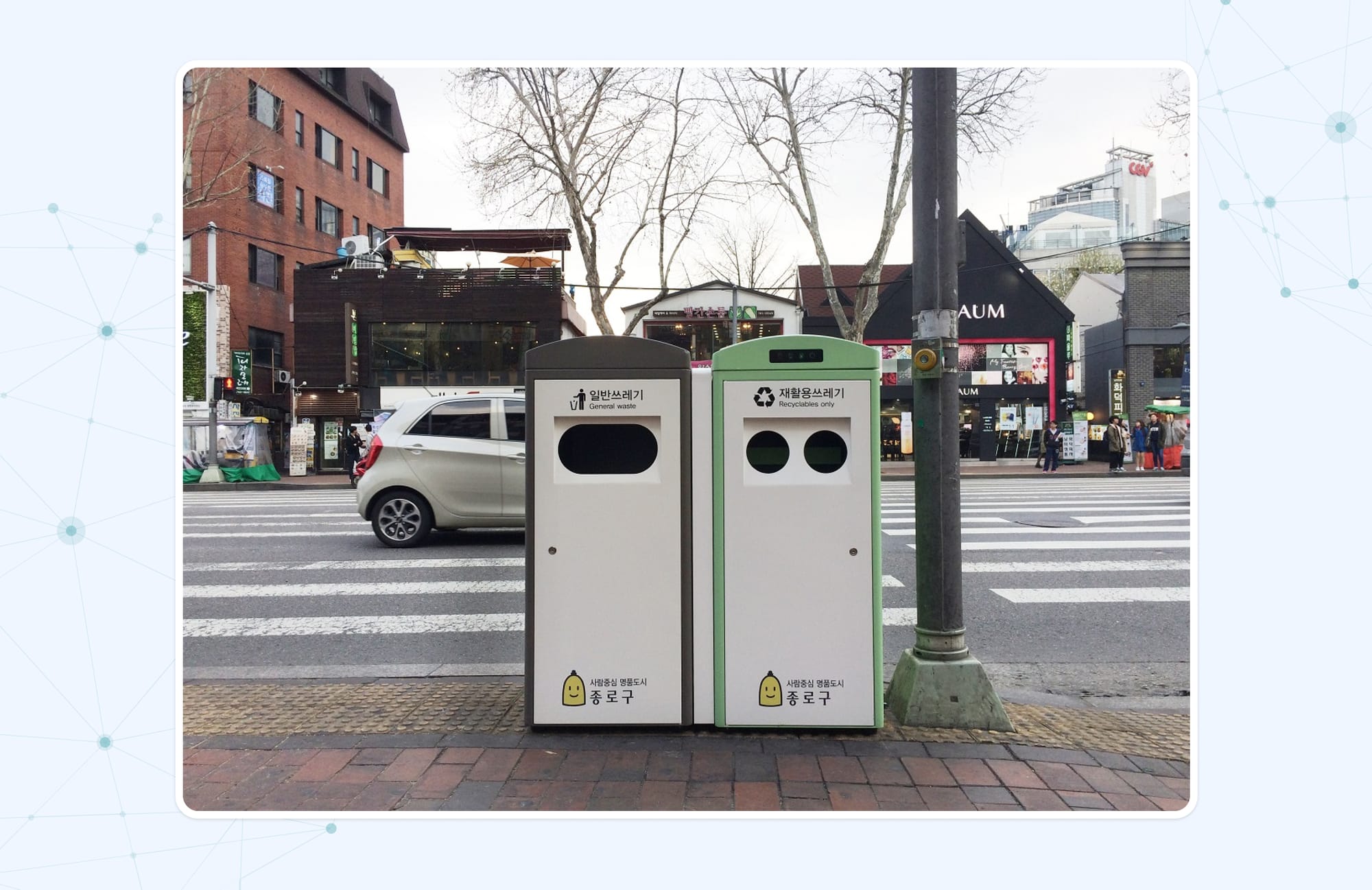
To connect CleanCUBE bins globally, Ecube Labs joined forces with Vodafone, leveraging their global M2M managed network connectivity. The eSIM technology facilitated seamless communication between the CleanCUBE bins and central systems, allowing real-time status reports. This not only reduced unnecessary collection visits but also provided invaluable data for planning waste management effectively.
In Ecube Labs calculated that if waste removal in Seoul decreases by just 10%, carbon emissions can go down by about 1,000 tons. Based on trials and projections, their team estimates that replacing 5,000 bins in Seoul with their bins could lead to over a 20% decrease in waste removal within a year and a half. This reduction is equivalent to planting 150,000 trees in Seoul by cutting down on CO2 emissions from waste removal fleet operations.
Developing a platform for global IoT connectivity

Verizon Business has launched the Global IoT Orchestration platform. This is a solution for wireless IoT that combines two important technologies: native eSIM and roaming capabilities provided by mobile network operator (MNO) partners. This innovation is integrated into the Verizon ThingSpace IoT management platform, enabling businesses to deploy and manage IoT devices worldwide through an all-in-one management interface.
With native eSIM provisioning, devices can establish international connections using eSIM profiles provided by Verizon's global carrier partners. In doing so, these devices can function as if they were subscribers in the service area of the partner carrier, gaining access to comprehensive technical, commercial, and multi-network coverage features. Through collaborations with telcos in different locations (such as Bell Canada or Norwegian Telenor), customers can oversee and control eSIM connectivity spanning the U.S., Canada, Europe, and the Asia-Pacific region.
By using native eSIM provisioning, Verizon's B2B clients companies that are focused on the U.S. market but operate globally can maintain reliable connectivity across the world. This is comparable to a U.S. customer's seamless connectivity when traveling between different states. The platform eliminates the necessity of depending solely on roaming services, providing a reliable and flexible solution for businesses that operate in different geographical areas.
Jazeera Airways partners with 1GLOBAL to improve travel connectivity with eSIM integration

Jazeera Airways is a Kuwaiti low-cost airline. It aims to provide cost-effective communication solutions for its passengers, eliminating expensive roaming costs and increasing customer satisfaction. Recognizing the need for innovative offerings, Jazeera is looking to become the first airline in the MENA region to introduce its own travel eSIM.
Partnering with 1GLOBAL, innovators in eSIM-based GSM mobile services, Jazeera Airways is now working on integrating consumer eSIM technology into its service offering. 1GLOBAL is famous not only for its eSIM-based GSM mobile services but also for Telco-as-a-Service offerings for travel companies, and affordable roaming options for everyday consumers. The company has expanded its footprint to 12 countries and holds the distinction of being a fully regulated mobile virtual network operator (MVNO) in nine of these countries.
The collaboration begins with implementing a Jazeera-branded QR code and web-based solution, progressing to an in-depth integration into the Jazeera Airways app. Jazeera expects that this white-label solution will allow it to maintain its unique branding while offering eSIM services.
The airline company plans for the eSIM to provide access to high-quality 5G and 4G coverage in almost all countries with flexible tariff options. As a result, travelers who activate the 1GLOBAL roaming eSIM will experience more cost-effective communication than traditional roaming plans. This is expected to gain customer loyalty, give the airline a chance to set itself apart from competitors and boost ancillary revenues.
Wrapping up
As many smartphones now support eSIM, some even exclusively, that leaves telecom companies with little choice but to embrace this transformative trend. The integration of eSIM has become almost imperative for modern companies leveraging AI and entering the IoT market. And iSIM will be the next inevitable step in this revolution.
Still have some questions about eSIM and iSIM technology and how you can adopt them? We at Flyaps will be glad to use our wide experience in developing applications for managing eSIM-based IoT devices to help you. We will assess your needs and plans and help you choose the best possible set of features, including roaming billing, forecasting and budget planning. So, drop us a line and we will be more than happy to bring your ideas to life.

